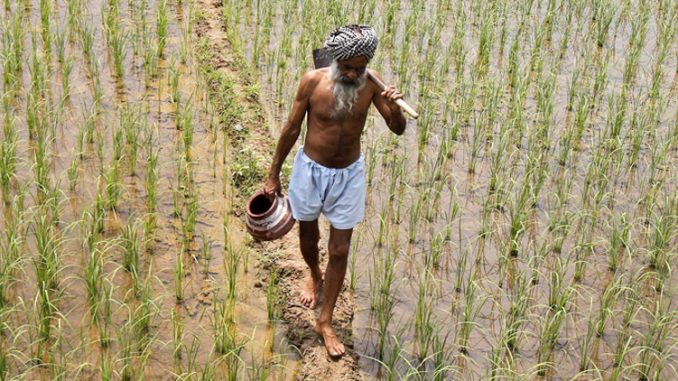
As the Narendra Modi government completed two years in office, almost each arm of government issued hordes of advertisements celebrating achievements and delineating policies and programmes that were transforming India. The ministry of agriculture and farmers’ welfare came out with a big picture of PM Modi, spelling out 10 points reflecting the government’s agri-vision and strategic interventions to transform Indian agriculture. Topping this list were: “Farmers’ income to be doubled in five years”, followed by the Pradhan Mantri Fasal Bima Yojana, Pradhan Mantri Krishi Sinchayee Yojana, soil health cards, organic farming, self-sufficiency in pulses and oilseeds, neem-coated urea, national agriculture market (eNAM), mobile app, and disaster relief.
A reality check would necessitate a rigorous scrutiny of each one of these 10 points. But here we take up the issue of doubling farmers’ incomes in five years, which tops the Modi government’s agri-agenda.
Let us first map the existing landscape of the Indian farmer’s income and later identify the associated challenges of doubling it. It is common knowledge that Indian farmer households do not depend solely on the cultivation of crops because they also earn incomes from farming animals, undertaking businesses in the non-farm sector and/or even from working as wage/salary earners within or outside agriculture. The National Sample Survey Organisation, in its situation assessment survey of farmers (SAS), conducted once every 10 years, assesses the major sources of income of an average Indian farmer. The latest required information is available for agri-year 2012-13. The SAS 2002-03 results are also available, which we use for comparison purposes. The income of farming households is shown under four heads: Cultivation of crops, farming animals, rural non-farm activities (RNF) and wages/salaries (WS).
The SAS 2012-13 counts 9 crore agricultural households in India, with each earning on an average Rs 77,112 per annum. This was more than three times of what it earned in 2002-03, that is Rs 25,380. In real terms (using the consumer price index of agri-labourer or the CPI-AL as the deflator with base 2004-05), however, the average agri-household’s income increased from Rs 26,901 pa in 2002-03 to Rs 38,096 pa in 2012-13. The 10 year compounded annual growth rate (CAGR) of the respective incomes was 11.8 per cent in nominal terms and 3.5 per cent in real terms. This means that it took about six years for nominal incomes to double and it would take about 20 years for real incomes to double!
Now, the question really is: Is the Modi government targeting doubling farmers incomes in real terms or in nominal terms? If it is in real terms, as some enthusiasts within the government claim, it would be a daunting task to double farmers’ incomes in five years as it would require an average annual growth rate of 14.4 per cent. If the government can achieve that it would be the best performance of any government, a game-changer benefiting millions of households in the country. But if it is in nominal terms, the job is relatively easy and closer to what India has already experienced during 2002-03 to 2012-13.
In terms of income sources, cultivation remains the main source for an average Indian agri-household and in the last 10 years, its contribution increased from 46 to 48 per cent. The contribution of income from the farming of animals showed the most change: From a 4 per cent share in 2002-03, it increased to 12 per cent in 2012-13, perhaps on account of rising livestock demand. The share of income coming from RNF and WS fell from 11 per cent and 39 per cent in 2002-03 to 8 per cent and 32 per cent in 2012-13, respectively.
As far as dependence on farming animals and wages and salaries is concerned, it reduced with the rising size of landholding. About 67 per cent of India’s operational landholdings are smaller than 1 hectare and for them, the major source of income (about 70 per cent) is from farming of animals and daily wage employment.
A state-wise analysis reveals that growth in nominal incomes varied between 17.5 per cent (Haryana) and 6.7 per cent (West Bengal) and that of real incomes varied between 8.3 per cent (Odisha) and minus 1.1 per cent (West Bengal).
What lessons can the Modi government learn from this decadal change for his vision of doubling farmers’ incomes in the next five years? The biggest learning is clear: Within a horizon of five years, the government can possibly aim to double only nominal incomes and not real ones, unless there is something dramatic in the package of reforms, which we don’t see in the list of 10. This should bring some humility in the announcements. Further, with two-thirds of the country’s landholdings being marginal, the relevance of farming animals, rural non-farm activities, and wages and salary employment cannot be overstated. This means the future strategy for doubling incomes has to be bolder towards the livestock sector and towards RNF employment. Skilling farmers and agri-labour on a large scale will support this.
As cultivation of crops still continues to contribute most to an agri-household’s income, combining a productivity-augmenting drive with diversification into high-value agriculture is more necessary than optional. Building value chains for fruits and vegetables, somewhat akin to what India did for milk — aggregation of the produce at the village-level, grading and packaging it, and using the modern logistic network to distribute it — can augment incomes in a sustainable manner. Mother Dairy’s “Safal” is another good model to keep in mind in this regard.
In sum, unless the whole agri-system rises to the occasion, the dream of doubling farmers’ income in five years may remain a dream. And a farmer may still have to look up to the sky for any hope of revival, or even survival.
Source: The Indian Express

Leave a Reply